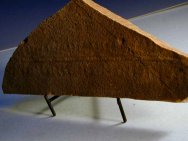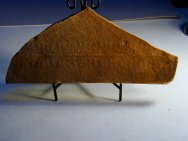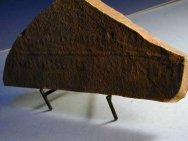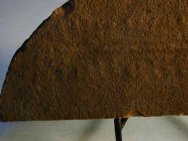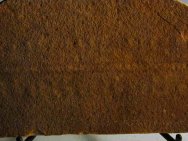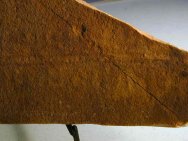Name: Protichnites Trace Fossil (Ichnofossil)
Geologic Time: Upper Cambrian
Size: (25.4mm=1 inch): 13 by 6 inches
Fossil Site: Krukowski Quarry, Mount Simon or Wonewoc Sandstone, Elk Mound Group, Mosinee,Wisconsin
Code: DD59
Price: $250.00 - sold
|
This Protichnites specimen is unique among all I have seen from the Krukowski quarry. The matrix is comprised of much finer sandstone that the vast majority of the quarry horizons. This finer type of matrix also contains the most well preserved madusae fossils. The Prototypical tail or body appendage track in epirelief is thicker than most. The most unique aspect of this specimen is apparent arthropod footprints running parallel and on both sides of the specimen; these are very subtle, wider than most Protichnites and difficult to discern in bright light. They are, however, apparent in the side-lighted photography used in the pictures below. It is reasonible to assume given the lack on ripple that the track was made well above the high-tide waterline, perhaps in a silty pond that would have allowed the more subtle tracks to be made. Are the footprints and tail drags from the same animal? Is the animal that made both the same as the one that made the body impression at this link? Or, is it a different ichnogenera, given that no similar trackway has been found in the quarry? Notable in Protichnites is the prominent markings of a tail or other body part being dragged; footprints, when present, are subtle by comparison. The maker of these fossil trackways might have been an animal resembling the extant but ancient horseshoe crab, except of an early design that lacked a hard shell to be preserved. Others have posited that Protichnites was a soft-bodied progenitor of the large, now extinct group of early predators, the Eurypterids (Chalicerate "biting claws" Arthropods). The "Eurypterid theory" is particularly intriguing since it would imply that just as animals were first moving to land to feed, hungry new predators were already on the hunt. If a Eurypterid-like animal made these tracks, it would probably have been an ancestor of the later eurypterids except with a soft body with no exoskeleton to preserve. Also see: Cambrian Shadows |
